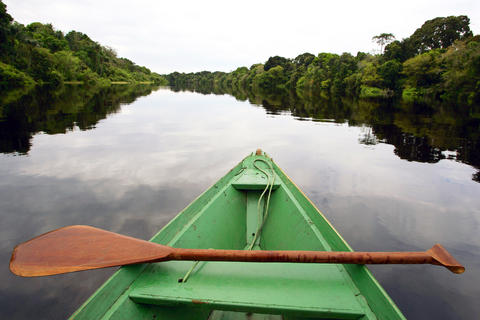Depending on one's point of view, the World Wildlife Fund's financial support of a nature reserve here on the Rio Negro is either part of a laudable attempt to conserve the Amazon jungle - or the leading edge of a nefarious plot by foreign environmental groups to wrest control of the world's largest rain forest from Brazil and replace it with international rule.
In 2003, after signing an agreement with the WWF and the World Bank, the Brazilian government created the Amazon Region Protected Areas program. Since then, more than a score of national parks and reserves covering an area larger than New York, New Jersey and Connecticut combined have been brought into that network and provided with an infusion of new funds.
The program's objective is to set up "a core system to anchor biodiversity protection for the Amazon," Matthew Perl, the WWF's Amazon coordinator, said during a visit to the area last month, a sparsely populated archipelago of 400 islands northwest of Manaus. "It's part of a strategy to buy time, bring each protected area up to certain standards of management and pool resources for monitoring and enforcement."

PHOTO: NY TIMES NEWS SERVICE
But that effort has aroused the suspicions of powerful business and political groups in Brazil that want to integrate the Amazon into the country's economy through dams, mining projects, highways, ports, logging and agricultural exports.
"This is a new form of colonialism, an open conspiracy in which economic and financial interests act through nongovernmental organizations," said Lorenzo Carrasco, editor and coauthor of The Green Mafia, a widely circulated anti-environmentalist polemic. "It is evident these interests want to block the development of Brazil and the Amazon region by creating and controlling these reserves, which are full of minerals and other valuable natural resources."
Such views are widely held in Brazil, cutting across regional and class lines. In a survey of 2,000 people in 143 cities conducted in person in 2005 by the country's leading polling organization, Ibope, 75 percent said that Brazil's natural riches could provoke a foreign invasion, and nearly three out of five distrusted the activities of environmental groups.

PHOTO: NY TIMES NEWS SERVICE
Winning the battle for Brazilian public opinion is crucial to any global effort to preserve the environment and, by extension, curb climate change. Brazil is the world's fourth-largest producer of the principal greenhouse gases; more than three-quarters of those emissions result from deforestation, most of which occurs here in the Amazon.
But the notion that foreigners covet the Amazon has long been widespread in Brazil, fed in part by anxiety about the central government's tenuous control of the region. Those concerns have been exacerbated in recent years by the Internet, which has become a home for fabricated documents and declarations meant to convince Brazilians that their sovereignty is at risk.
The most notorious example is a widely reproduced map supposedly used in an American middle-school geography textbook. Rife with misspellings and errors of syntax of a type common to speakers of Romance languages like Portuguese, it shows the Amazon as an "international reserve," and describes Brazilians as "monkeys" incapable of managing the rain forest.
Other spurious documents say that both US President Bush W. Bush and Vice President Al Gore made speeches during the 2000 presidential campaign in favor of wresting the Amazon from Brazil. Elsewhere, the documents quote an apocryphal American general, who leads an agency that the Pentagon says does not exist, as saying, "In the event Brazil decides to use the Amazon in a way that puts the environment of the United States at risk, we must be ready to interrupt that process immediately."
Since the Iraq war began, accusations of US military designs on the Amazon are often invoked to denigrate environmentalists and their complaints about government policy. At hearings late last year on a proposed dam on the Madeira River, proponents distributed a map showing what they said were US "forward-operations locations" in the region meant to block Brazil's development, including military bases and advisers in Bolivia and Venezuela, two countries not exactly on friendly terms with the Bush administration.
Some of the material circulating has been traced to right-wing nationalist groups sympathetic to the military dictatorship that ruled Brazil from 1964 to 1985. But in an unusual instance of former adversaries agreeing, organizations on the extreme left - even in the governing Workers' Party - have also endorsed the notion of a foreign plot to seize the Amazon, as have some active duty segments of the military.
"Everything indicates that the environmental and indigenous problems are merely pretexts," said a recent Brazilian military intelligence report, which was made available to the New York Times by a Brazilian who received a copy and who was concerned at the views expressed. "The main NGOs are, in reality, pieces in the great game in which the hegemonic powers are engaged to maintain and augment their domination. Certainly, they serve as cover for those secret services."
In reality, Perl, the WWF coordinator, said, his organization hopes merely to create a buffer around the nature reserve here through the creation of a larger "Rio Negro Conservation Bloc." He said the idea was to protect the existing reserve by helping existing Indian reservations, state parks and nature reserves along the banks of the river to operate more effectively.
By 2012, Perl said, his organization and its partners hope to bring an area larger than California into the system. A fund administered by a Brazilian foundation that aims to raise US$390 million and includes donations from the German government and others has been created.

In the March 9 edition of the Taipei Times a piece by Ninon Godefroy ran with the headine “The quiet, gentle rhythm of Taiwan.” It started with the line “Taiwan is a small, humble place. There is no Eiffel Tower, no pyramids — no singular attraction that draws the world’s attention.” I laughed out loud at that. This was out of no disrespect for the author or the piece, which made some interesting analogies and good points about how both Din Tai Fung’s and Taiwan Semiconductor Manufacturing Co’s (TSMC, 台積電) meticulous attention to detail and quality are not quite up to

April 21 to April 27 Hsieh Er’s (謝娥) political fortunes were rising fast after she got out of jail and joined the Chinese Nationalist Party (KMT) in December 1945. Not only did she hold key positions in various committees, she was elected the only woman on the Taipei City Council and headed to Nanjing in 1946 as the sole Taiwanese female representative to the National Constituent Assembly. With the support of first lady Soong May-ling (宋美齡), she started the Taipei Women’s Association and Taiwan Provincial Women’s Association, where she

Chinese Nationalist Party (KMT) Chairman Eric Chu (朱立倫) hatched a bold plan to charge forward and seize the initiative when he held a protest in front of the Taipei City Prosecutors’ Office. Though risky, because illegal, its success would help tackle at least six problems facing both himself and the KMT. What he did not see coming was Taipei Mayor Chiang Wan-an (將萬安) tripping him up out of the gate. In spite of Chu being the most consequential and successful KMT chairman since the early 2010s — arguably saving the party from financial ruin and restoring its electoral viability —

It is one of the more remarkable facts of Taiwan history that it was never occupied or claimed by any of the numerous kingdoms of southern China — Han or otherwise — that lay just across the water from it. None of their brilliant ministers ever discovered that Taiwan was a “core interest” of the state whose annexation was “inevitable.” As Paul Kua notes in an excellent monograph laying out how the Portuguese gave Taiwan the name “Formosa,” the first Europeans to express an interest in occupying Taiwan were the Spanish. Tonio Andrade in his seminal work, How Taiwan Became Chinese,